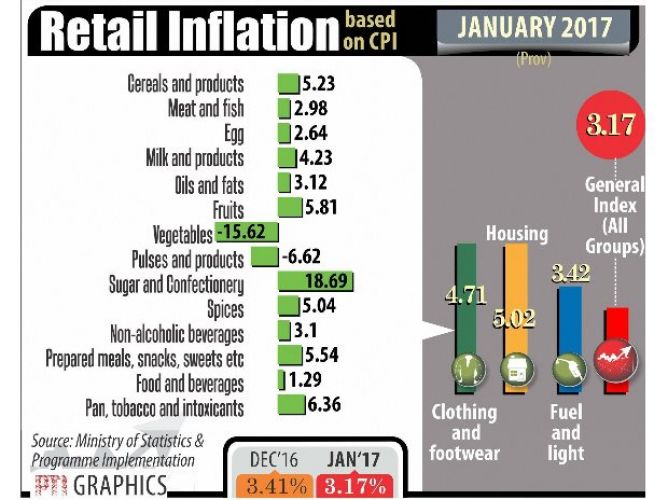
Retail inflation dipped to a five-year low of 3.17 per cent in January mainly on account of the declining prices of food items, including vegetables and pulses.
The fall in the inflation rate was because of weak demand from households hit by a cash crunch after demonetisation along with a seasonal increase in the supply of vegetables.
Retail inflation, measured in terms of Consumer Price Index (CPI), was 3.41 per cent in December and 5.69 per cent in January 2016.
Inflation in vegetables continued to be in the negative zone at (-)15.62 per cent against (-)14.59 per cent a month ago. The price rise in pulses also came in at a negative (-) 6.62 per cent.
Aditi Nayar, principal economist at Icra, said, "A favourable base effect and sequentially softer prices of vegetables and pulses contributed to the decline in CPI inflation in January 2017. A reversal in the base effect and the seasonal rise in prices of perishables are expected to push up the next two readings of CPI inflation. We continue to expect March 2017 inflation to exceed 4.5 per cent."
Inflation in fruits was higher at 5.81 per cent and that of fuel at 3.42 per cent. The rate of price rise in meat and fish was 2.98 per cent.
Overall, the consumer food price index was down to 0.53 per cent in January against 1.37 per cent in December.
"Food inflation has crashed and activity indicators are showing continued weaknesses. The household sector's inflation expectations have fallen sharply. If this scenario continues for the next two months, the RBI may consider cutting the rates for the last time before entering into a long pause," Rupa Rege Nitsure, group chief economist at L&T Finance Holdings, said.
Also Read:-
Abhishek Bachchan for the first time to portray a Dark Lover
Work easily, communicate with Amazon Chime
5.27 lakh respond to queries over suspicious deposits